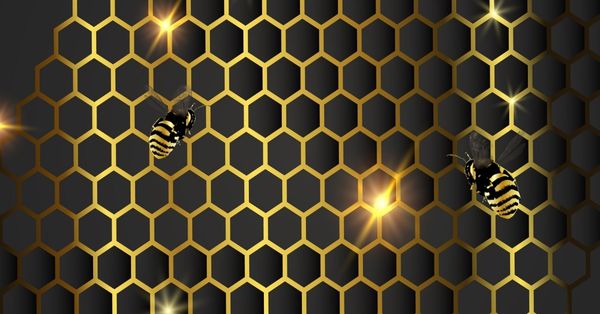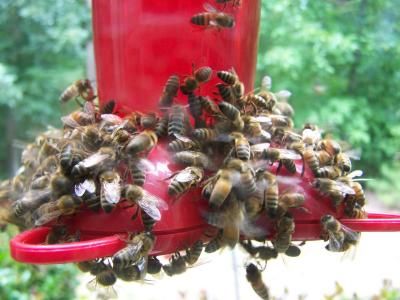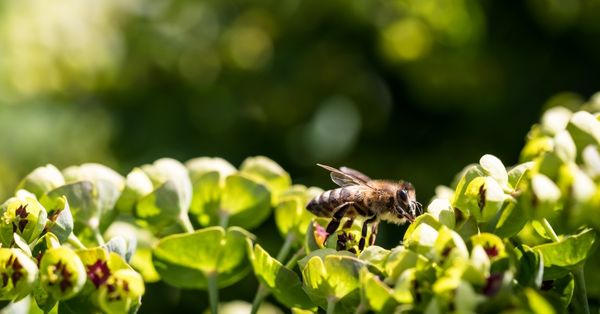Hummingbirds are drawn toward feeders with rich nectar recipes; however, bees are drawn to nectar as well.
Understanding how bees and birds behave may assist us in resolving our feeding problem.
However, the subject of how to drive bees away from hummingbird feeders persists.
There are several methods to do this without hurting birds or bees.
Here are some of the most effective tips.
How to Keep Bees Away From Hummingbird Feeders?
1. Install Bee Guards

If you design your hummingbird feeder bee-resistant, you should create the feeding pores narrower to ensure that no bees or any other insects may get inside.
Certain hummingbird feeders may arrive with bee shields already installed.
The first step would be to purchase a good feeder with a bee guard; however, if you already own a feeder, you might simply add a bee shield.
Hummingbirds possess lengthy beaks and tongues that allow them to access nectar sources, primarily within flower vaults.
Using a sieve or bee shield around the feeding openings prevents bees from flowing through the openings, preventing them from reaching the nectar and finally giving up on chasing it.
Bees may only summon reinforcements if they are able to reach the nectar. If just a handful of inspecting bees fail to acquire the nectar, there will be no bee swarm.
This is the Hummingbird Feeder with Bee Guard that I recommend, Check it out on Amazon.
2. Make use of Red Saucer Feeders

Hummingbirds could use their large tongues to get the nectar, while insects cannot. Hummingbirds are drawn to the color red, whereas bees are drawn to the color yellow.
Some hummingbird feeders are much less insect-friendly than many others, based on the kind of feeder you choose.
With saucer feeders, place nectar far enough back from the feeding inlet that insects cannot get it.
Other feeder models contain built-in ant drainage ditches or bee screens, which are particularly intended to keep insects out of the nectar without preventing the hummingbirds from feeding.
Any nectar feeder can be upgraded with additional attachments.
Bees may be directed to a basin containing a mixture of one to two parts sugar and one part water. Place a plate in close proximity to the hummingbird feeder.
When the bees have been drawn to the bowl, relocate it to a bright location a bit too far away from the source.
3. Move the Feeder Around Frequently

When hummingbirds identify a food supply, they might return regularly and hunt for new food sources easily accessible.
Moving hummingbird feeders on a regular basis might help to confuse bees and prevent them from coming from hummingbird feeders.
Regardless of whether you relocate the feeder a few meters away, the bees will probably find it again shortly. Changing the feeder too frequently will confuse both the hummingbirds and the bees, so keep in mind your plan for shifting the feeder is rigorous but not overly rigid.
In most cases, insects will only visit handy sources and not look for moved hummingbird feeders. Relocating the feeder a few meters may reduce bug visitation without deterring hummingbirds.
This will be simple to execute if your backyard has many feeding sites where birders just alter and where various feeders are placed across the backyard each time the feeders are refreshed.
Ants will be kept away from hummingbird feeders using this strategy.
4. Make Use of Decoy Feeders
Using a feeder identical to your hummingbird feeder but particularly made for honeybees is an effective technique for keeping them away from hummingbird feeders.
Put this bee feeder beside the hummingbird feeder, install it in the direct daylight bees enjoy, and add a better sugar mixture of water. Bee bait is something that has a water-to-sugar proportion greater than 5-to-1.
Put this fluid in a shallow dish approximately 5 or 6 meters away from hummingbird feeders. You may need to set up closer to the feeder and work your bit far away from it.
This is going to keep bees around long enough just to pollinate your blossoms even while offering a new food source for them.
Always remember that flies will initially seek out the most efficient sources of food, so whether you’re using a bowl or any bird feeder, ensure the feeding station remains accessible to the bees.
5. Find and Stop the Leakage

Spills from feeders are one of the most likely reasons why you aren’t able to keep bees away from feeders. You cannot afford to overlook any cracks or leaks in your feeder.
Dripping delicious sugar water attracts various insects, such as ants, to hummingbird feeders. A tiny leakage is not a cause for worry; however, when the drips and spills become somewhat constant and substantial, the flow must be stopped.
To decrease leakage, there are several techniques for fixing a feeder and fortifying the seals. The function is done by a good seal between both the bottle reservoirs and the feeder apertures. A poor or unequal sealing may quickly leak.
Use the plumber’s adhesive over the holes where the feeder fits together to strengthen the seal and reduce any leaks. To avoid any contamination, keep the adhesive away from the nectar.
6. Reduce the Sweetness of the Nectar

Sugar, particularly sucrose, is a favorite of honey bees. When there are lots of nectar supplies nearby, bees will avoid flowers whose nectar has a reduced sugar percentage, such as pear blooms.
Because they are seeking sugar, you should adjust the sugar proportion in your bird feeder so that when the insects lose all interest in the sugar syrup. Consider a 5:1 water-to-sugar proportion for your bird feeder.
Bees like larger sugar content; therefore, offer them a sugar proportion that fits them within their own feeder. For hummingbird feeders, the usual water-to-sugar combination is 1: 4.
A single additional piece of sugar in some kind of bee feeder is enough. For bees, wasps, and other bugs, the ideal water-to-sugar-water proportion might be 3:1, with changes as needed.
7. Anything Yellow Should Be Avoided
Bees are instantly attracted to the color yellow due to the color of blossoms as well as other sources of food, wherein they gather nectar and pollen.
Red, on the other hand, does not attract them. To reduce bee attraction, consider feeders having yellow insect screens or floral accents.
If your feeder contains yellow paint all over it, repaint it with red using non-toxic paints. The HummZinger feeder is a nice example of a feeder that inhibits bees since it lacks yellow.
Certain shades, such as yellow and blue, get a greater impact on bees than the others. Bees perceive in a bit distinct range than humans.
They are able to perceive the UV portion of the electromagnetic spectrum, whereas humans cannot. Bees also lack the ability to perceive the color red due to this sort of eyesight.
The color black warns bees to keep away by signaling danger.
8. Grow a Pollinator Garden

Bees are responsible for over 80% of all flowering plants’ pollination, including 70 of 100 of the world’s top human food plants. Bee pollination contributes to around one-third of the food we eat.
If you have another flower supply of nectar that the bees can’t refuse, they might avoid the hummingbird feeder. You might also utilize pollination seeds to establish hummingbird flowers and enjoy the amazing hum emanating from your yard.
The plants you pick for pollination gardening might vary based on temperature, region, and soil composition. To maintain plentiful food sources for as long as feasible, mix annuals and perennials and pick flowers having staggered blooming dates.
Hummingbird and bee-friendly flowers comprise Petunia, Trumpet Creeper, Bee Balm, and Zinnia. With the exception of Bee Balm, all of these plants have a yellow tint that attracts bees.
9. Regularly, Clean the Feeder
As birds drink, drops of nectar might unavoidably fall from their beak over onto the feeder. Hummingbird feeders may also leak when they are overfilled. Due to the air pressure within, the nectar is driven away from the feeder.
When refilling hummingbird feeders, wipe the exterior as well as the feeding outlets thoroughly to eliminate any dropped nectar. Take the time to fix any pores and fix damaged feeder components to reduce leakage.
Even if they are little, visible honey splatters may bring insects, especially bees, toward your feeder. Insects can detect nectar leaks and sticky spots and take full advantage of any spillage.
Cleaning hummingbird feeders on a constant schedule is suggested, yet it only requires 15 min of your time.
Hummingbird feeders are easy to use because they have a nice design and are very simple to maintain.
Check out this article on How to Keep Pigeons Away From Bird Feeders?
Conclusion
Although you will have a number of party crashers at your feeder, you are not required to exterminate them in order to maintain the honorees pleased.
You can ensure that your hummers are always supplied with nectar while ensuring that other insects such as bees and wasps are kept at bay with a cunning ruse.
FAQ
Do Hummingbirds Fear Bees?
Hummingbirds are not scared of bees. Both nectar-loving species compete to share the same food supply. Hummingbirds avoid locations with a high concentration of bees simply because there is intense conflict.
After all, one bloom can only contain so much honey. The buzzing bird might be better off searching for a less buzzing location.
Last Updated on March 22, 2023 by Lily Aldrin
